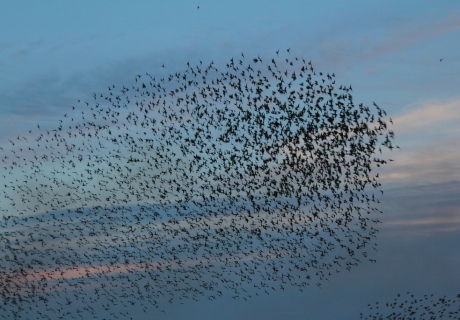

A scientist has shown mathematically that the dynamics that govern swarms and bird flocks may also govern the properties of things like magnets.
The researcher from Imperial College London has developed a mathematical equation to understand more about motility. This phenomenon refers to the ability of individual birds, insects or cells to actively influence the overall shape of swarms, flocks and human tissue. Scientists call these motility systems active fluids to describe how these organisms as a whole can move on their own.

Dr Lee’s find suggests parallels between a flock and a physical model such as a magnet
A fundamental question currently concerning some scientists is whether active fluid models bear any resemblance to the way that molecules influence the overall structure in physical models such as magnets and cell membranes. If similarities between the two models can be found then scientists could apply what they already know about physical models to active fluids, paving the way for a deeper understanding of them.
My work has shown a connection between active fluid models and physical models, which was a real surprise to me.
– Dr Chiu Fan Lee
Department of Bioengineering
Now, Dr Chiu Fan Lee from Imperial and his collaborators in China and the USA have formulated an equation for understanding the principles behind motility in a generic active fluid model. They compared the generic active fluid model to a well-known physical model that is governed by the Kardar-Parisi-Zhang equation.
Dr Lee found parallels between the two, which enabled him to draw on the principles of the Kardar-Parisi-Zhang equation and predict the behaviour of the generic active fluid system. In essence, this breakthrough means there may be parallels between laws that govern active fluids and physical models.
To contextualise, a swarm has a number of arrows or vectors in the form of insects that are all pointing in the same direction, enabling the organism to function as a whole and move seamlessly in the same direction. Dr Lee’s find suggests parallels between a swarm or a flock and a physical model such as a magnet, which has arrows or vectors in the form of electrons that need to align in the same way in order for there to be magnetism.
Dr Lee, from the Department of Bioengineering at Imperial, said: “My work has shown a connection between active fluid models and physical models, which was a real surprise to me. Making this connection means that we may be able to apply well known principles behind physical models to active fluids, paving the way for real breakthroughs in a range of scientific fields.”
The Imperial researcher is now aiming to apply the same methods to analyse other active fluid systems commonly found in biology. Specifically, he is aiming to classify living matter into distinct classes characterised by their macroscopic behaviour – much like how chemists classify elements according to the number of protons in the atoms in the Periodic Table.
In particular, Dr Lee is looking at how aging cells affect the overall dynamics of skin cells. This work could eventually lead to a deeper understanding of how aging affects the overall dynamics of human tissue, which is important because it may pave the way for better treatments for healing wounds.
Article text (excluding photos or graphics) available under an Attribution-NonCommercial-ShareAlike Creative Commons license.
Photos and graphics subject to third party copyright used with permission or © Imperial College London.
Reporter
Colin Smith
Communications and Public Affairs

Contact details
Email: press.office@imperial.ac.uk
Show all stories by this author
Leave a comment
Your comment may be published, displaying your name as you provide it, unless you request otherwise. Your contact details will never be published.




Comments
Comments are loading...